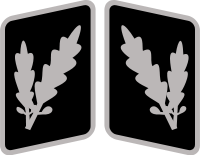- Oberführer
-
The title of this article contains the character ü. Where it is unavailable or not desired, the name may be represented as Oberfuehrer.
Oberführer was an early paramilitary rank of the Nazi Party dating back to 1921. Translated as “Senior Leader”, an Oberführer was typically a Nazi Party member in charge of a group of paramilitary units in a particular geographical region. From 1921 to 1925, the phrase Oberführer was used as a title in Sturmabteilung, but became an actual SA rank after 1926.
Oberführer was also a rank of the Schutzstaffel (SS, at that time a branch of the SA), established in 1925 as Gauführer, a rank for SS officers in charge of SS personnel in the several Gaue throughout Germany; in 1928 the rank was remamed Oberführer, and used of the commanders of the three regional SS-Oberführerbereiche. In 1930, the SS was reorganized into SS-Gruppen and Brigaden, at which time Oberführer became subordinate to the higher rank of Brigadeführer.
By 1932, Oberführer was an established rank of both the SS and SA and was considered the first general officer rank, approximately the equivalent to a Brigadier. Oberführer wore two oak leaves on the uniform collar rank patch, along with the shoulder boards and lapels of a General Officer. In 1938, the status of SS-Oberführer began to change with the rise of the SS-Verfügungstruppe which would later become the Waffen-SS. Since Brigadeführer was rated equal to a Generalmajor, and Standartenführer to an Oberst, Oberführer had no military equivalent and quickly became regarded as a Senior Colonel rank. This distinction continues in historical circles with most texts referring to Oberführer as a Senior Colonel rank[1] while some others state it has a military equivalent to a British Army Brigadier-General.[2]
One of the more famous holders of the rank of Oberführer was Julian Scherner, immortalized in the film Schindler's List as the cold and calculating SS and Police Leader of Kraków[citation needed]. Emil Maurice, the actual founder of the SS in 1925, also held the rank of Oberführer.
References
- ^ Yerger, Mark C. (1997). Allgemeine-SS: The Commands, Units and Leaders of the General SS, Schiffer Publishing Ltd., p. 235. ISBN 0-7643-0145-4
- ^ McNab, Chris (2009). The SS: 1923–1945, Amber Books Ltd., p. 186. ISBN 1906626499
Junior Rank
StandartenführerSS rank and SA rank
OberführerSenior Rank
BrigadeführerCategories:- SS ranks
Wikimedia Foundation. 2010.

